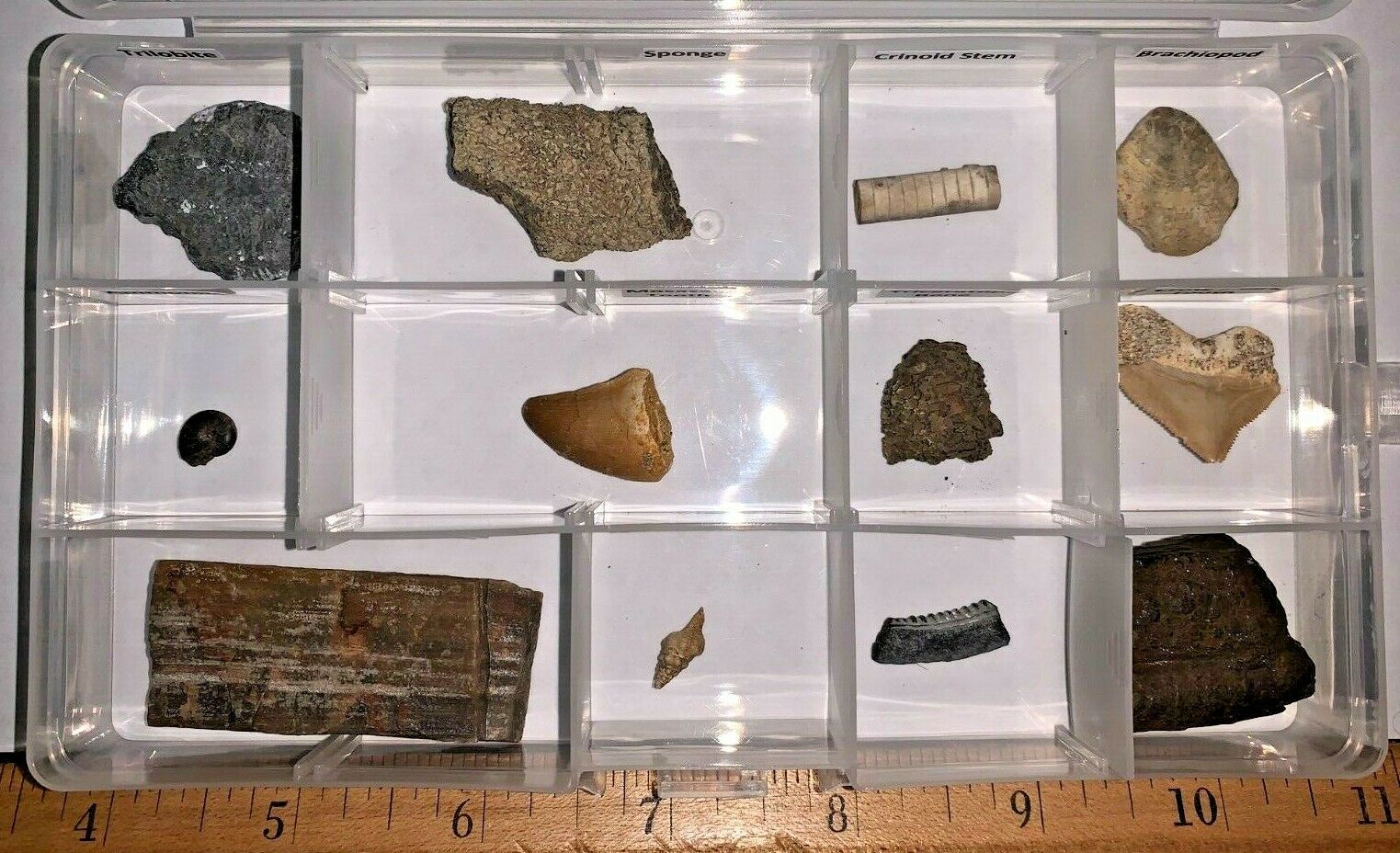-40%
Labeled 12 Fossil Lot Fossil Collection TRICERATOPS BONE, HORSE TOOTH, ELRATHIA
$ 10.56
- Description
- Size Guide
Description
Hi all!These are Labeled Collection of Fossils from across earth's history going back to before the first dinosaur! Each fossil is labeled to correspond with the following information sheet and come in a clear adjustable case for easy transport and display! The 12 fossils included are; a
Triceratops Bone Fragment, Mosasaur Tooth, Crow Shark Tooth,
partial
Elrathia
Trilobite, Ammonite, Extinct Ice Age Horse Tooth, Crinoid Stem, Gastropod, Stingray Tooth, Sponge, Brachiopod,
and a piece of
Petrified Wood
!
The case is 6.75 x 4 x 1 inches.
The size and quality of each fossil varies from case to case. Above are pictures of ten different collections to give you an idea of the size and quality of the fossils you will
receive
.
Makes a fantastic gift for science enthusiasts of all ages! Combined shipping is available for orders or multiple items!
Trilobite:
(Elrathia
kingii
) Trilobites are arthropods that lived from 521 to 252 million years ago. They come in many shapes and sizes. Some would roll into a ball like roly polies. This Specimen is an Elrathia trilobite from the Cambrian of Utah, between 513 and 498 million years old.
Sponge:
(Wewokella sp.) Sponges are primitive animals that first appeared over 580 million years ago. They absorb food directly from water as it flows through the holes in the sponge called pores. This is a specimen of the sponge Wewokella from the Pennsylvanian of north central Texas, approximately 300 million years old.
Crinoid stem:
Crinoids are echinoderms, animals related to starfish. Crinoids first appeared about 480 million years ago. They look like flowers and are sometimes called sea lilies. The “flower”, called a calyx, had multiple arms that would filter food particles from the water and put them in the mouth in the center of the arms. They attach themselves via a stem and roots to the bottom of the sea floor. This specimen is a partial stem from the Pennsylvanian of north central Texas, approximately 300 million years old.
Brachiopod:
(Composita sp.) Brachiopods, also called lamp shells, are animals with two shells like clams that filter food out of the water. They are not at all related to clams, however. They first appeared approximately 550 million years ago. This specimen is a Composita brachiopod from the Pennsylvanian of north central Texas, approximately 300 million years old.
Ammonite:
Ammonites are Cephalopods, like squid and octopi, that had a coiled shell. They lived from 409 to 66 million years ago and ranged in size from less than an inch to over six feet (two meters) across depending on the species. This specimen is from the Jurassic of Morocco between 200 and 145 million years old.
Mosasaur Tooth:
Mosasaurs are huge carnivorous marine reptiles that lived alongside dinosaurs from 101 to 66 million years ago. Some approached 60 feet (18 meters) in length! They aren't dinosaurs but are close relatives of snakes and lizards. This specimen is from the Cretaceous of Morocco, about 75 million years old.
Triceratops Bone:
(Triceratops sp.) Triceratops is an enormous, plant-eating dinosaur with three horns and a frill that lived all over North America in large herds during the Late Cretaceous. They grew to 30 feet (9 meters) and nearly 10 tons! This bone fragment is from The Hell Creek Formation of Montana, about 68 to 66 million years old.
Crow Shark Tooth:
(Squalicorax
pristodontus
)
Crow sharks are medium sized sharks that live and died with the dinosaurs. Like all sharks, they had many rows of teeth and would shed old ones to be replaced by new ones. This is the largest species of Crow shark and grew to lengths of 16 feet (5 meters). This specimen from the Cretaceous of Morocco, about 72 million years old
Petrified Wood:
Petrified wood is a special type of fossilized wood that occurs when the organic molecules in the wood are replaced by minerals, usually quartz. This specimen is from the Eocene of College Station, Texas, between 50 and 40 million years old.
Gastropod:
(Latirus
moorei
)
Gastropods (Snails) are mollusks with coiled shells that move along the ground or sea floor. They eat plants or actively hunt other animals, depending on the species, and first appeared 540 million years ago. When a snail dies, its shell usually dissolves leaving only an internal mold of the shell. This specimen is rare in that the original shell was preserved. It is a Spindle snail from the middle Eocene of College Station, Texas, about 42 million years old.
Stingray Tooth:
(Myliobatis sp.) Stingrays are close relatives of sharks. Eagle rays, a type of stingray have broad triangular fins and flat teeth for crushing shellfish. The ridged side of the tooth is actually the root. This specimen is from the late Miocene or Pliocene of Florida, between 10 and 2.5 million years old.
Extinct Ice Age Horse Tooth:
(Equus sp.) Horses lived in North America for millions of years before going extinct about 11 thousand years ago. A different species of domestic horse was reintroduced to North America by European settlers in 1519. This specimen is from the Pleistocene
of
Florida, between 1 million and 11 thousand years old.
All of my items come with a Certificate of Authenticity! If I have a fossil or mineral listed up as something, I make darn well sure that's what it is!
I do combined shipping on all items upon request!
I have all sorts of fossils and minerals for sale at great prices and I upload new items frequently! Click on seller info to see my other items!
Thank you for reading please contact me with any questions.
Have a wonderful day!
Jako




















